
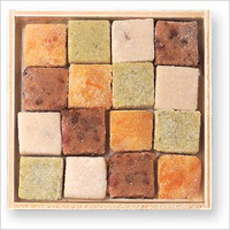 Transitioning from asummer palette to a fall one are marzipan squares from Burdick Chocolate.
|
 |
Gourmet News Archives
September 2005
9.26.05
The Finest Ham of Them All...Will Be Here Soon. Jamón Ibérico is perhaps the best of all hams, just as truffles are to mushrooms or Kobe is to beef. The great news for Americans who haven't tasted this delicious ham (or those who don’t get to Spain often enough) is that the USDA has finally approved a Jamón Ibérico production facility and the ham may be exported to the U.S. as soon as the end of this year.
This unexpected and long-awaited news should garner cheers from all who have tasted the flavorful meat from rare pata negra (Iberian black-hoofed pigs) that live only in Spain. The pigs are given about 5 acres to roam and consume 15 to 20 pounds of bellotas (acorns) daily, which allows the pigs to gain about two pounds of body weight every day. This diet contributes to the pungent nutty flavor of the ham as well as the exquisite marble appearance of the meat. In fact, the quality of the ham is so exceptional that the meat is said to contain healthy mono-unsaturated fats with benefits comparable to olive oil.
Tender and rich in flavor, these hams are a result of hogs that have been royally raised since birth. American foodies may be lucky enough to enjoy Ibérico lomo (pork loin), chorizo and other Ibérico sausages even before Christmas. |
|
Jamón Ibérico will soon be exported
to the U.S. so foodies can appreciate
the special ham without having to fly
to Spain. |
The paletas (shoulders) will be available in another year, and it will be about two years until Americans can enjoy the full Ibérico jamónes (hams). The traditional, bone-in Iberian black-hoofed pig takes twenty-three months to cure: the approved producer, La Tienda, has just hung them to cure in the mountain and the hams are projected to be available in the U.S. market by fall of 2007. The best of these hams will be around $1,000 per ham. Over 300 foodies have already placed $199 deposits for the hams with LaTienda.com to secure a purchase. If you can’t wait for you’re piece of hog heaven, place your pre-order here.
Pomegranate 101. Pomegranates have long stumped consumers. The fruits are fascinating with their beautiful cranberry-like hue, but they need an instruction book. If you slice open a pomegranate, you will see that its tangy fruit is contained in several hundred fleshy arils—juice sacs surrounding the edible seeds. These are what you eat to enjoy the flavor of the pomegranate. Tasty but not exactly neat eating, most Americans have steered clear of eating pomegranates.
With ancient origins stretching between Iran and northern India, pomegranates are finally getting the attention they have long deserved. Brought into the national limelight two years ago by the California-based POM Wonderful (the largest pomegranate grower in the U.S.) with its bottled fresh pomegranate juice, this fall, consumers will get to eat the real thing without any of the confusion. POM Wonderful will be introducing ready-to-go packs of pomegranate arils on the West Coast. |
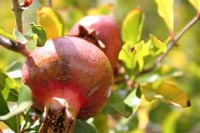 |
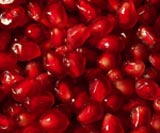 |
You may have seen a whole
pomegranate at the market
but never ventured to try it. |
The pomegranate arils—the
"meat" or “seeds” of the fruit
at the left. |
Pomegranate juice has become a popular cocktail mixer not only because of its beautiful color, but also for its rich anti-oxidant contents. With the arils packaged and ready-to-eat, pomegranates may just be the next trendy “superfood.”
9.19.05
Sake American-Style. Now that Americans have taken a greater interest in tasting and understanding saké, it is no coincidence that SakéOne’s extra-aged G debuted this month, tailored to the American palate, in stylized modern version of a traditional saké bottle. This new super-premium saké is a hybrid between fine wine and traditional saké, with flavor undertones of fruit to tropical spices. “G” refers to genshu sake, a particular style with an alcohol content of 18% (genshu means undiluted or “cask strength”).
Although saké is brewed from grain, like beer, it is categorized as wine because of its similar alcohol levels. Saké, a 6,800 year old alcohol with origins in China as far back as 4800 B.C., is a fermented beverage containing rice, water, yeast and a special enzyme, koji, required to activate the yeast. Saké was further refined in Japan and has become one of Japan’s signature beverages. There are more than 14,000 different sakés produced by 1,800 sakéries worldwide. Most are in Japan, but there are four sakéries on the west coast of the United States (of which one, SakéOne is American-owned), producing approximately 200 different sakés.
Award-winning Japanese sakés are usually rich in earthy tones and aromas that require connoisseurship. G was created as a top-quality saké with nuances that are more familiar to American palates, enabling Americans to appreciate fine saké while minimizing unfamiliar elements.
G is intended to be served chilled—a concept still relatively new to Americans who know only warm saké (a carafe of “house sake” is the equivalent of house wine—a bulk product hardly representing the best of the genre, but enjoyable with cuisine). Saké is a versatile drink that has the skill to enhance just about any food, but goes exceptionally well with sumptuous Asian cuisines or finely prepared seafoods. Served warm or cold, it is also an ingredient many chefs use in place of cooking wines.
|
|
 |
SakéOne’s G comes in a sleek black bottle—a sophisticated approach contrasting to the traditional Japanese bottles. If you enjoy martinis, try a bottle: while saké is a different animal entirely, its temperament appeals to many martini-lovers. At right, a traditional saké bottle. |
Saké, which contains anywhere between 4% to 21% alcohol content, generally falls into two categories: junmai and honjozo. Junmai means that no distilled alcohol has been added; honjozo is defined as no more than 5% distilled alcohol is added. In Japan, about 88% of all sakés made have distilled alcohol added (honjozo). Adding distilled alcohol to saké is illegal for sakés made in the United States, but honjozos can be imported into the United States.
Within both junmai and honjozo styles, there are several types of quality, determined by how much of the outer kernel of the rice is milled away. Milling discards the kernels’ protein and fatty acids, leaving behind starch at the center of the kernel—starch is what gets converted to alcohol. The more outer coating that gets milled away, the higher the quality the saké will be—and the more expensive.
Saké has entered the limelight for several reasons. Aside from its elegant flavors and a range of styles from dry to fruity, saké has no sulfites, to many Americans are allergic. Saké has one-third the acidity of wine, making it more palatable to people who need to refrain from higher-acid foods. Premium saké is practically hangover-free because of its pureness (although that’s no excuse to over-indulge!). Lastly, saké is an excellent base for cocktails, as many people have noticed at their favorite watering holes (not just the Sakétini, Saké Cosmo, Saké Sangria, Sake Colada, but more colorfully-named cocktails like the Great Tsunami, Fujiyama Sunset, Blushing Geisha, Ume Kiss, and Silent Ninja).
For more information about G, visit SakeOne.com
Eye Candy You Can Eat. Another “G,” Godiva Chocolatier, is also in the news this week. With the increasing awareness of artisanal chocolatiers, celebrity artisans like the Food Channel’s Jacques Torres, and the ease of purchasing and gifting products from the websites of boutique chocolate shops anywhere in the country, the established international “prestige” chocolatiers need to show that they’re more than the same old, same old.
Just launched into the competitive mix is Godiva’s new Platinum Collection, featuring 15 new chocolates in an assortment of pralines, mousses, caramels, fruit creams, and ganaches. Platinum bridges the classic and the new in both designs and flavors. Designs range from the traditional to modern patterns reminiscent of pioneering chocolate artists like Richart. Au courant flavors include Nocturne, a 72% cocoa ganache; Gingevere, a spicy ginger ganache, and Limetta, a key lime cream; while traditionalists can find Chérie, a cherry cordial, Orangelide, an orange cream, and V.S. Comtesse, a ganache laced with brandy.
Platinum chocolates are available in boxes of 4, 8, 16, 30, and 60 pieces at Godiva retail shops, fine retailers, and at Godiva.com.
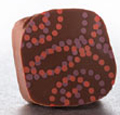
|
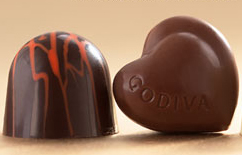 |
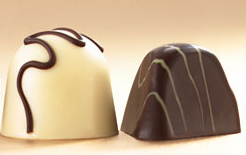 |
| Pieces from the Godiva Platinum collection. Below left, the gaily patterned top of Gingevere, a spicy ginger ganache. Images copyright Godiva Chocolatier, Inc. |
9.12.05
Dakota Organic Beef Expands. Dakota Beef LLC, America’s leading certified organic beef company, has expanded into Ohio, launching at the Whole Foods store in Columbus. An extensive range of its certified organic meats, including its new Organic All Beef Hot Dog (a NIBBLE favorite), will be available. Certified organic beef products mean that animals are treated humanely to develop their full potential, are never administered antibiotics or growth-promoting hormones, and are raised on certified organic pasture. Dakota Beef finishes its cattle on a mix of certified organic grains to ensure that the beef is tender and flavorful. A store locator is available at the company website, and if there’s no retail locator near you, you can order their excellent products from the website. |
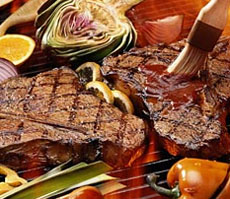 |
Dakota Beef products are also available at
WilliamsSonoma.com. |
Super Sauerkraut: More Than a Dress For Your Dog? Sauerkraut, meaning “sour cabbage” in German, has been gaining popularity in cocktails, diets, and even dessert recipes. Commonly eaten as a topping for hot dogs, sauerkraut is becoming the next versatile “superfood.” Why? Possibly linked to the recently published study of sauerkraut in the Journal of Agricultural and Food Chemistry, sauerkraut’s prime ingredient, cabbage, was reported as a potent vegetable source that reduces cancer and aids healthy digestion. Cabbage is a cruciferous vegetable, a plant in the mustard family (including mustard greens, cauliflower, broccoli, kale, radish, Brussels sprouts, and others). |
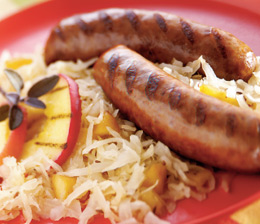 |
| |
In a study published in the October 2002 Journal of Agricultural and Food Chemistry, studies showed that frequent cruciferous vegetable consumption resulted in dropping cancer rates as much as 40%. Studies done in the U.S. have also shown sauerkraut to be a libido booster too. Since these publications, a sauerkraut boom has been on the rise (possibly explaining those sauerkraut cocktails).
If you’re in Oregon or Ohio at the right time, check out these upcoming sauerkraut festivals:
- Scappose Sauerkraut Festival
September 17, 2005
Heritage Park: Columbia County, Oregon
10 a.m. to 4 p.m.
- For more information contact:
Lisa Smith, 1.503.543.2010 or
Ronda Courtney, 1.503.827.8203
|
- Annual Ohio Sauerkraut Festival
October 8-9, 2005
Waynesville, Ohio
- For more information call:
1.513.897.8855
|
A Guide to Smart Seafood Purchases. Seafood Watch has free pocket guides on how to make eco-friendly choices in purchasing seafood. Guides are available for each U.S. region, and can be ordered or downloaded immediately online.
If you care about purchasing and eating sustainable seafood at home and at restaurants—that which comes from sources, either fished or farmed, that provide the seafood without jeopardizing the suppply or the environment—download a regional Seafood Watch card here. |
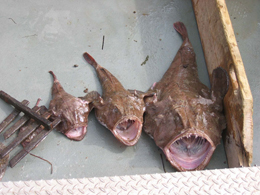 |
| The monkfish supply is depleted at the moment—please chose something else. Photo courtesy of National Marine Fisheries Service. |
9.5.05
Hello, Ethel...So long, Starbucks? For many people, there will never be such a thing as too much chocolate. With cocoa body scents, fudge face masks, blended chocolate drinks, upscale chocolatier shops, and even chocolate movies, it’s no surprise that chocolate lounges are springing up nationwide. In fact, you’d think that sitting down to enjoy chocolate in many forms would have been a heaven invented long ago. Well all good things come with time because if you don’t see a chocolate café in your state now, you may find one moving in close by soon.
This rather new idea is predicted to be the next big hit for the food/chocolate industry since chocolate lounges have been gradually opening since the early 90s. While chocolatiers have recently begun to realize the benefits of adding a chocolate café, like Jacques Torres, who opened a new haven on the westside in New York City last October, other areas have jumped on the band wagon sooner.
Now with three chocolate cafés battling it out on Michigan Avenue, Chicago is one of the many places where chocolate lounge competition is up and coming. One of them is Moonstruck Chocolate Company, a Portland, Oregon based company that prides itself in offering artisanal chocolates and rich cocoa and espresso beverages for the summer and winter seasons. So you can achieve your chocolate ecstasy in the form of blended drinks to bite size chocolate cones filled with flavored chocolates from banana split to razzleberry.
But also on Michigan Ave, is Ethel’s Chocolate Lounge, owned by Mars Inc., where the interior design almost looks like it stepped out of “Charlie and the Chocolate Factory”— fashionably delicious with different shades of rosy pinks and chocolate browns. The menu doesn’t skimp on the chocolate essentials so you can get your dark chocolate fondue or top off your truffles with extra kicks like ginger citrus. Have some tea and chocolate cocktails to make your experience a meal.
To top those two, Hershey’s Chicago opened a brand new interactive all-in-one chocolate bar just three months ago.
|

|
| Ethel's plush love-seats and chocolate colored walls will have you feeling chocolaty too. Photo courtesy of Barry Brecheisen for Metromix. |
You can customize your own candy, desserts, beverages, and gifts, and baked goods. Too tired of creating? Sit down at the bakery and enjoy a custom-made or pre-concocted chocolate drink.
A handful of specialty chocolate shops have begun to realize that people not only will buy chocolate from expensive glass cases, usually for jewelry display, but that having a chocolate fix with some friends is worth splurging on. In Oakland, California the Bittersweet Chocolate Café is a small shop with about 4-5 tables only. With hot or iced beverages, you can get spicy cocoa or mocha infused espressos. But you can also get a fine plate of bread and cheese to balance your palate, as well as a chocolate lesson that includes a platter of cacao beans and fine chocolates from a variety of places. If you can't bear to leave the cozy chocolate haven, the cafe has a wall stocked with fine chocolates shipped from all over the world so that you may purchase a piece of pleasure before you leave. A new one will be opening in San Francisco this coming fall.
Vosges Chocolate is projected to open a new boutique in Los Angeles, California and another in New York City in 2006. Known for its exotic blends of savory chocolates, each Vosges has a beverage bar boasting its Aztec Elixir—a chocolate drink blended with ancho and chipotle chili peppers (read our review of their Bianca white chocolate elixir). Chocolate cafés are sprouting up everywhere even as you read this article!
Monterey Gourmet Finds a Niche in the Frozen Aisle. Monterey Gourmet Foods Inc. is venturing into the frozen food section with its new line of “OneStep Gourmet” meals. Monterey Gourmet Foods started out as a small, fresh pasta company that has branched out into offering over 100 various fresh and healthy gourmet foods. From organic to whole wheat, Monterey offers its food- conscious customers natural products as well as basic cooking tips. |
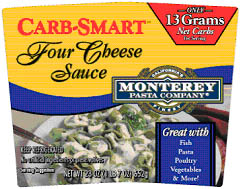 |
A new line of frozen products aims to serve restaurant-quality meals that can be prepared in a skillet and ready to eat a few minutes. The meals available include Grilled Chicken and Garlic Cheese Tortelloni in Zesty Marinara Sauce, Chicken, Broccoli and Tortelloni in Pesto Alfredo Sauce, and Shrimp and Garlic Cheese Tortelloni in Lemon Alfredo Sauce. If Monterey’s products can stay as wholesome and tasty in frozen packages, then they will be able to reach a new market seeking higher quality with quickserve convenience.
Lifestyle Direct Direct, Inc. All rights reserved. Images are the copyright of their respective owners.

|